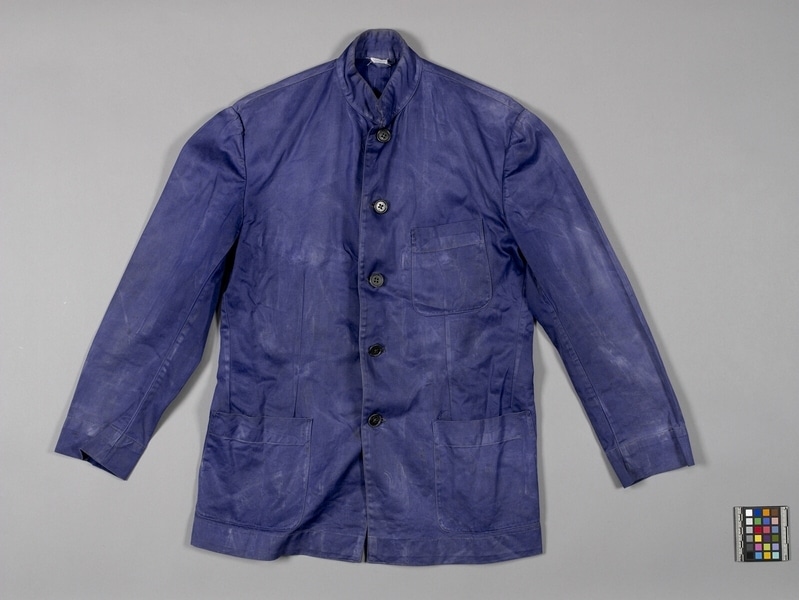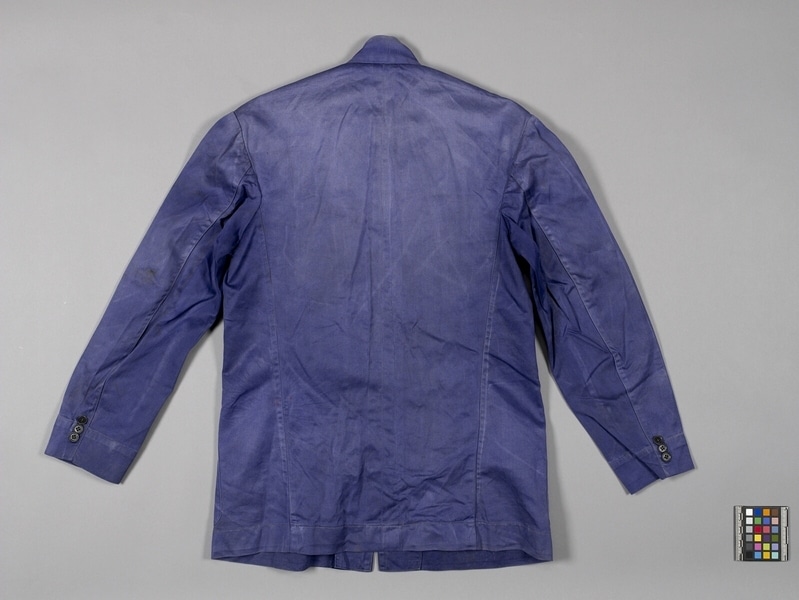Jacket Item Number: Edz1069 from the MOA: University of British Columbia


Description
Blue jacket. The jacket has a standing collar, long sleeves and a centre opening with plastic buttons. There is a row of three buttons on each sleeve cuff. There are two large pockets on the lower front and one smaller pocket on the upper left. The inside is unlined.
History Of Use
After the mid-twentieth century the New Territories of Hong Kong began to undergo fundamental changes. The people who had been settled there before 1898, when the British colonizers claimed the area, began to give up rice agriculture and coastal fishing, turning instead to wage labour and increased employment overseas. By the end of the century, educational opportunities leading to the possibility of white-collar work also increased, together with western influences. Men’s clothing reflected western influences earlier than did women’s clothing, which changed relatively little until the 1970s and even after. Shirts like this one reflect western influences in everything except the collar. This type of shirt was worn by men while working. Twentieth-century changes meant that objects and clothing once useful and appropriate were no longer needed and generally were discarded. Some were saved by their owners, who sometimes were willing to donate them to museums, sharing, also, their knowledge of how they were made and used.
Narrative
Mr. Chan, Kun-lam wore this shirt while working, in about the 1950s. By the time he donated it, the shirt was well-used and probably out of fashion. It had probably been custom-made for him by a tailor, which does not imply that he was wealthy. Tsuen Wan people were in general poor, but their clothing was still tailor-made. Hakka people are one of the two original land-dwelling groups that settled the area that became the New Territories of Hong Kong. Their spoken language, and some customs, differed from those of the other original group, the Cantonese or Punti. The Cantonese arrived first and settled on the best rice-growing lands, while the Hakka began to arrive after the late 17th century and settled the more hilly lands.
Item History
- Made in Tsuen Wan, Hong Kong, China during 1950
- Collected by Elizabeth L. Johnson during 1980
- Owned by Kun-lam Chan
- Owned by Elizabeth L. Johnson before March 17, 1980
- Received from Elizabeth L. Johnson (Seller) and Museum of Anthropology Shop Volunteers (Funding source) on March 17, 1980
What
- Name
- Jacket
- Identification Number
- Edz1069
- Type of Item
- jacket
- Material
- cotton fibre, dye and plastic
- Overall
- height 81.0 cm, width 80.5 cm
Who
- Culture
- Chinese: Hakka
- Field Collector
- Elizabeth L. Johnson
- Previous Owner
- Kun-lam Chan and Elizabeth L. Johnson
- Received from
- Elizabeth L. Johnson (Seller) and Museum of Anthropology Shop Volunteers (Funding source)
Where
- Holding Institution
- MOA: University of British Columbia
- Made in
- Tsuen Wan, Hong Kong, China
When
- Creation Date
- during 1950
- Collection Date
- during 1980
- Ownership Date
- before March 17, 1980
- Acquisition Date
- on March 17, 1980
Other
- Item Classes
- textiles
- Condition
- fair
- Accession Number
- 0610/0039